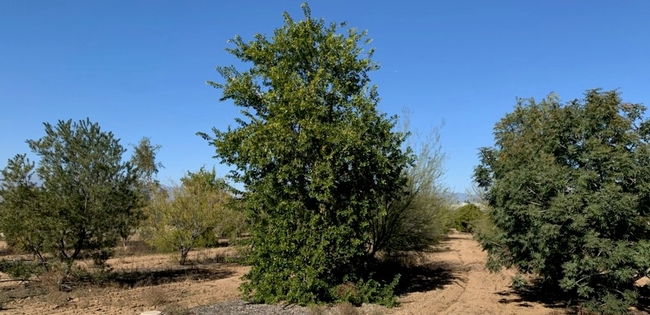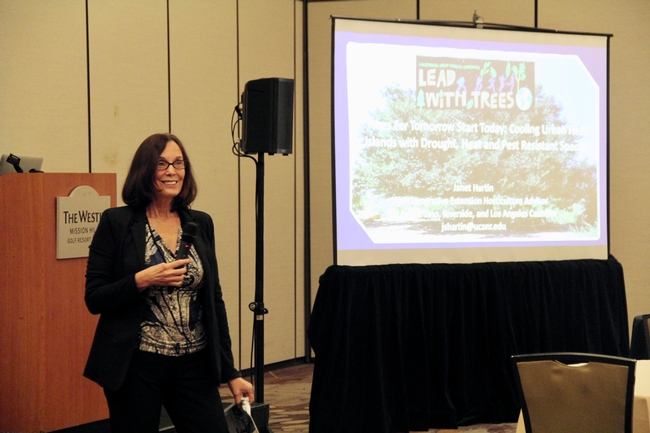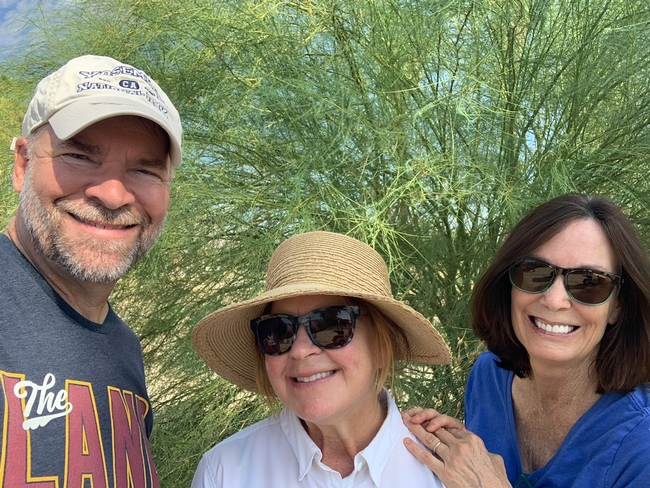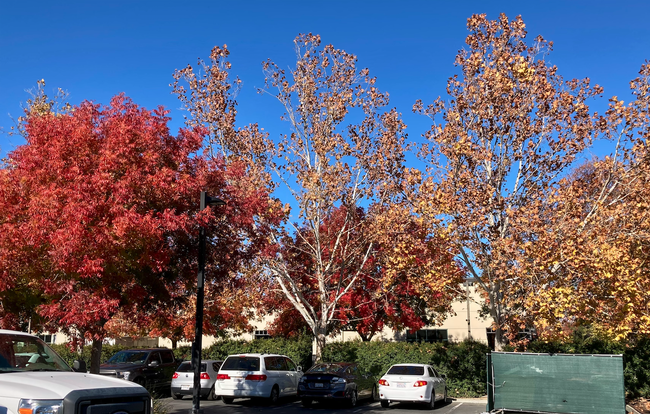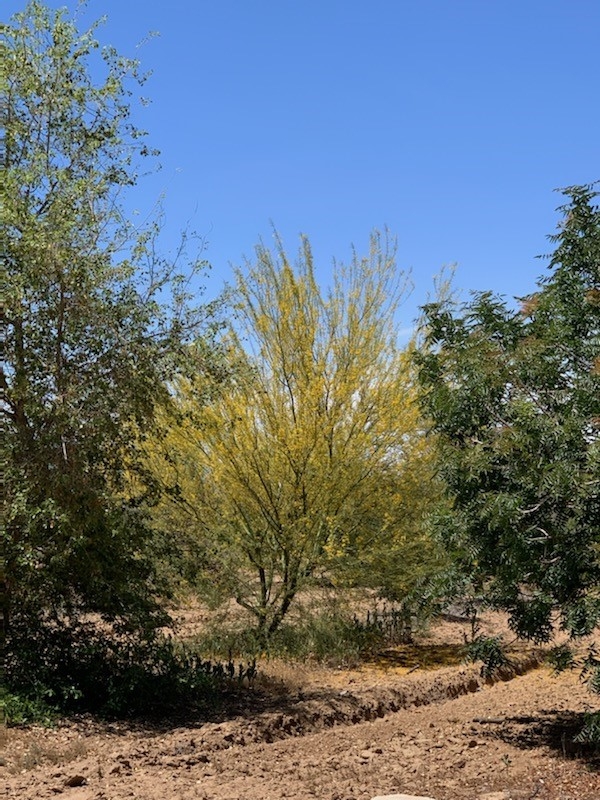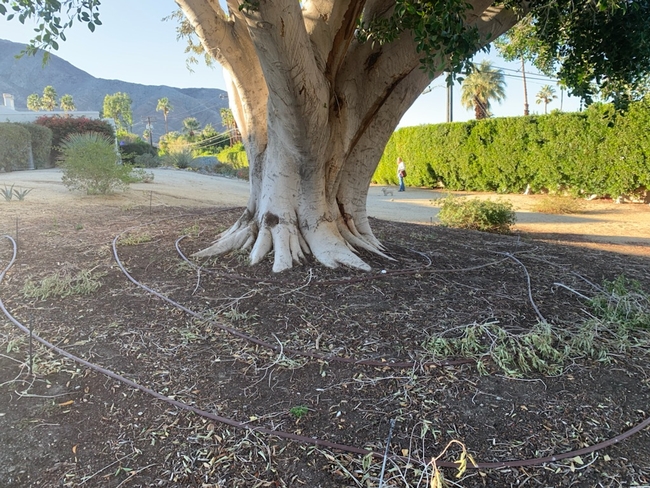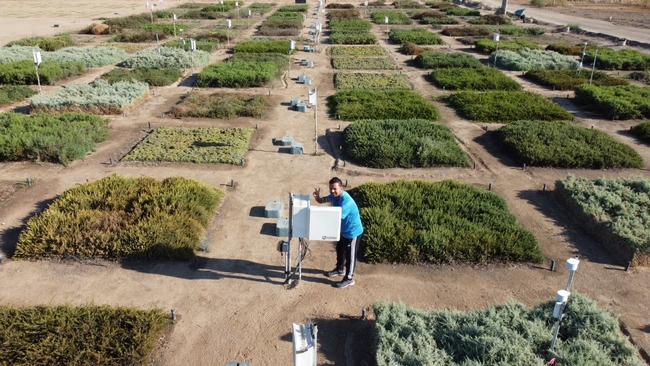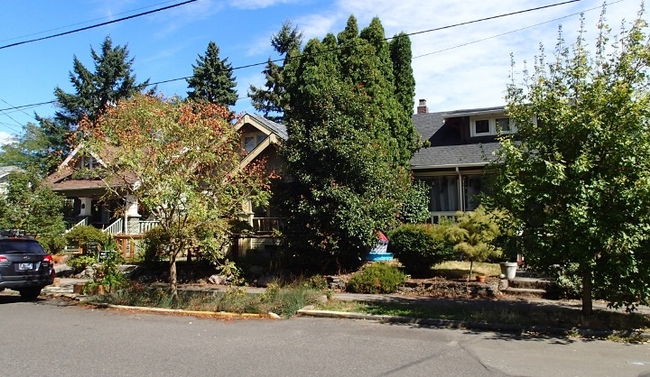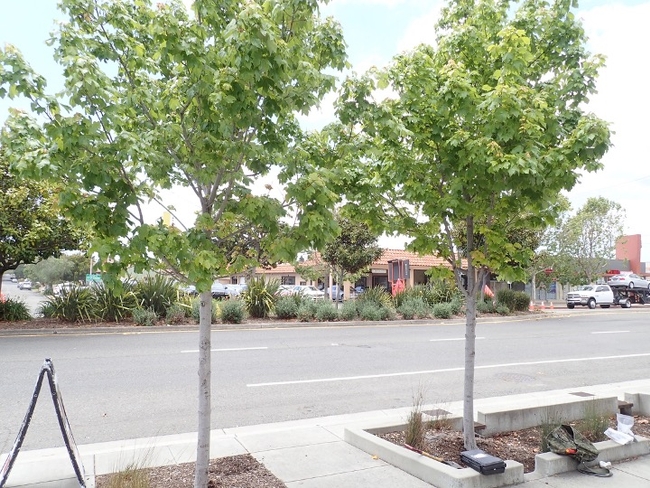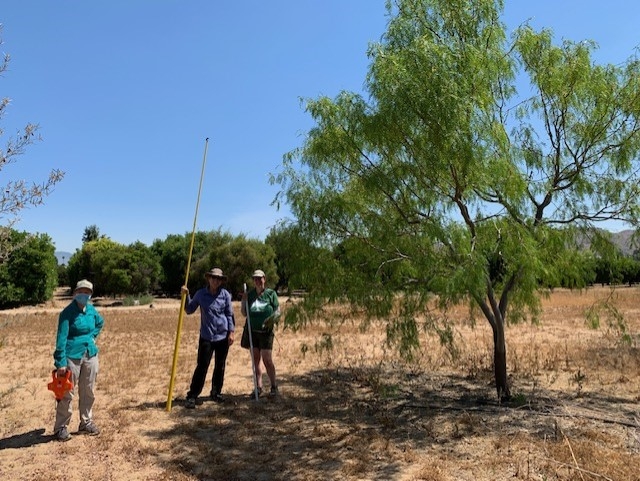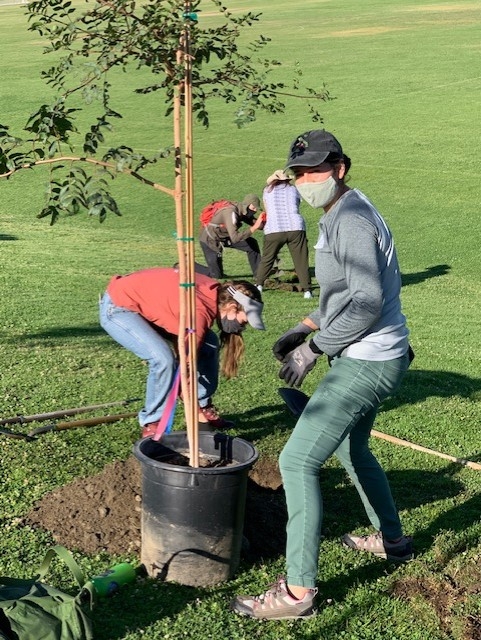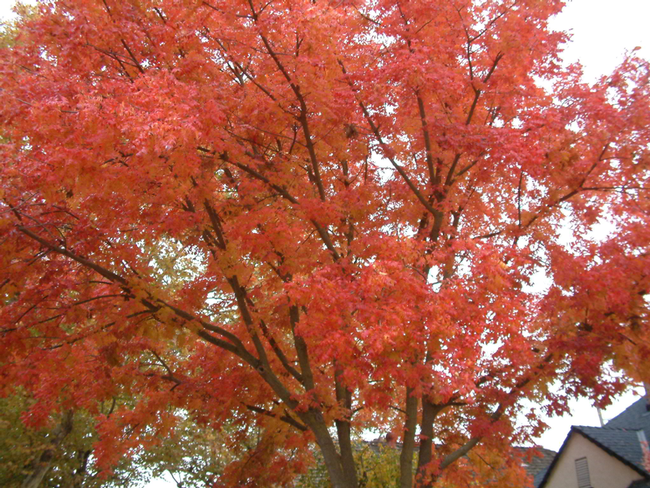Posts Tagged: trees
Now is the time to plant climate-ready trees, says UCCE researcher
In a drought-prone region like Southern California, working with Mother Nature is not only wise but necessary, according to Janet Hartin, UC Cooperative Extension horticulture advisor for Los Angeles, San Bernardino and Riverside counties, who studies climate-ready trees.
In 2020, Governor Newsom launched the California Climate Action Corps, empowering Californians to protect their communities from the impacts of climate change. Newsom's call to action emphasizes the need for long-term and sustainable solutions like Hartin's research, which urges Southern California to care for existing trees and plant new ones.
In collaboration with the U.S. Forest Service and other UC Cooperative Extension scientists, Hartin is amid a 20-year research study identifying trees suitable for California's different climate zones. Her work provides a comprehensive understanding of trees and their benefits related to human and environmental health, particularly as Californians navigate climate change's evolving challenges.
One of these concerns is urban heat islands. UHIs are areas in which heat is reradiated from paved concrete or asphalt surfaces. In cities covered in asphalt, like Los Angeles, average temperatures can become six degrees hotter than surrounding areas.
To reduce urban heat islands, she has been working with community organizations to plant trees. In March, for example, Hartin teamed up with the Inland Empire Resource Conservation District to increase tree canopy in the Inland Empire.
“We've collaborated extensively with her over the years, and we knew Janet had been developing a regionally scaled concept for connecting community members to climate-appropriate trees, alongside access to technical assistance from regional UCCE Master Gardeners to ensure long-term tree health and survival,” said IERCD District Manager Mandy Parkes.
Trees keep cities cool
To keep the city cool, some Los Angeles neighborhoods are repainting pavements with reflective coating. According to a 2020 study published in Environmental Research Letters, reflective coating can decrease pavement temperatures up to 10 degrees. As helpful as this is, augmenting urban landscapes to include heat-, drought- and pest-resistant tree species, whether native or not, can significantly reduce the impacts of urban heat islands too.
“Trees can cool impervious surfaces by 40 to 65 degrees,” Hartin said. During a 2021 study, in May and June Hartin discovered that unshaded asphalt could be more than 60 degrees hotter than shaded asphalt during late spring and early summer in inland and desert cities.
Other than providing shade, trees are effective at deflecting the sun's radiation and cooling the atmosphere through evapotranspiration. Given that they absorb and store carbon as well, trees lessen the impacts of pollution from fossil fuels.
“A well-tended mature landscape tree can absorb 40 tons of carbon over its lifespan,” said Hartin.
In a 2021 blog post, Hartin suggests trees be selected based on their adaptation to the “micro-climate” in each particular landscape, noting factors to consider like shade, proximity to buildings, space needs below and above ground, soil type and water source. She also recommends the Sunset Western Climate Zone maps for reference, noting that they are “more precise than USDA zones for our warmer climates.”
Based on the study with the U.S. Forest Service examining the performance of 12 species of underplanted but promising landscape trees at UC Riverside, favorable candidates include bubba desert willow and maverick thornless honey mesquite for their drought resistance, and red push pistache for its drought and heat resistance.
Tamara Hedges, executive director of UC Riverside Palm Desert Center and member of the Board of Directors for the Oswit Land Trust, agrees that trees are important in our fight against climate change:
“Through our partnerships with the UC California Naturalist and the Master Gardener Programs and many other nonprofits in the Coachella Valley, natural ecosystems are being protected and expanded and built environments cooled through the planting of appropriate tree species. These UC/USFS studies go a long way in identifying new underrepresented tree species."
General tips for planting
For California, planting in early fall through late winter provides ample time for trees to establish a strong root system before enduring the summer heat. Doing so also means that natural rainfall can fulfill water needs, as opposed to solely relying on irrigation systems.
Unlike newly planted trees, mature trees should be watered infrequently but deeply. Watering too often can reduce the level of oxygen in the rootzone and result in waterlogged soils prone to crown and root rots.
During the fall, trees only need about 15% of the water they would require in the summer. When watering, keep the tree trunk dry. Because the roots of the tree grow outward and are usually a foot deep into the ground, Hartin recommends watering the area around the trunk rather than the trunk itself. This will also help avoid water waste.
“Trees not adapted to the climate they're planted in and not receiving proper care are much more susceptible to invasive pests like shothole borers and diseases,” said Hartin. “Even the loss of one front yard tree can significantly reduce shade, increase the surrounding temperature, and diminish energy savings.”
Where do fall colors come from?
Did you ever wonder why trees "turn" color in the fall? The short answer: It's primarily a function of long, cool fall nights and short, sunny days.
The longer answer? Chlorophyll is responsible for the basic green color of leaves we see in spring and summer and is a necessary component of photosynthesis, which uses sunlight to manufacture sugar (food) that is stored during the dormant period of the year. Carotenoids produce yellow, orange and even brown pigments in crops such as carrots, squash, bananas and many ornamental plants such as daffodils and poppies. Anthocyanins are red and orange in color and are most linked to lavish displays of brilliant fall foliage. They also give rise to coloring of strawberries, plums and cherries.
Here's the kicker: While chlorophyll and carotenoids are present in leaf cell chloroplasts throughout the entire growing season, most anthocyanins are only produced in fall due to bright light and excess plant sugars within leaf cells.
So, in reality foliage doesn't "turn" orange or red at all. Carotenoids and anthocyanins are always in the leaves; they are simply unmasked once the active growing season is finished and chlorophyll is no longer produced. This happens when nights lengthen in fall.
Interestingly, the actual timing of color change varies across species and appears to be genetically inherited. The same species will exhibit a similar color scheme in cool temperatures in higher elevations at nearly the same time as it does in warmer lower elevation climates. The intensity can vary quite a bit however.
Where do temperatures enter the picture? Both the amount of color and the overall intensity of fall color is very linked to weather conditions that occur prior to and during the actual time the chlorophyll in leaves winds down. The most brilliant displays occur after several warm, sunny days and cool, crisp (above freezing) nights. This is because although lots of sugars are made in leaves during sunny daytime hours, the corresponding cool nights prevent the sugars from moving out. The amount of soil moisture also helps ensure that from year to year fall colors vary even in the same trees. So, either a late spring or a prolonged drought can both delay the display of fall color by a few days or even a few weeks.
What's the recipe for the most brilliant fall display? Most likely a warm, moist spring followed by a warm summer and sunny fall with cool autumn nights.
Although fall color is not nearly as spectacular in lower elevations of Southern California compared to other colder areas of the nation, the liquidambar or American sweet gum (Liquidambar styraciflua) offers some pretty impressive fall color and an impressive 300 to 400-year life span. (Did you know that liquidambar got its name because it at one time was a sought-after chewing gum for Native Americans?)
To help guarantee vivid colors for years to come, growers carefully propagate trees by cuttings to yield identical clones that will produce just as brilliant fall foliage as their parents. You may have come across the popular cultivar named Festival or even have one in your own yard. I like it because it stays more compact and columnar than most liquidambars. The downside? It is less cold tolerant than other liquidambars but does well in most warmer areas of Southern California.
The cultivar Moraine is broader and a better choice if one has adequate space for a shade tree; it is also adapted to cooler temperatures and it rewards homeowners and people passing by alike with beautiful, red fall foliage.
Save trees first: Tips to keep them alive during drought
Trees essential to lowering temperatures, cooling ‘heat islands'
Water restrictions prompted by the drought are driving Californians to prioritize how they will use their limited water. Because landscape irrigation is a major water use for many households, residents are looking outdoors to conserve water.
When choosing which landscape plants to save, “trees come first,” said Janet Hartin, UC Cooperative Extension area environmental horticulture advisor for San Bernardino, Los Angeles and Riverside counties. “Healthy communities need trees. Fortunately new California water restrictions allow for provisions to ensure trees receive adequate water to stay alive and healthy.”
“Mature trees are instrumental in cooling urban heat islands and we can't afford to lose them and start all over,” Hartin said. “Shade from mature trees can reduce surface temperatures by as much as 65 degrees in asphalt-covered parking lots. Shade from a single tree can reduce these surface temperatures from 165 to less than 100 degrees when air temperatures reach 110 degrees. Even with air temperatures in the 90s, surface temperatures can reach 140 degrees.”
In addition to providing shade, trees absorb and store carbon dioxide, release oxygen, enhance pollinators and wildlife habitat, filter pollutants from air and water and can reduce energy use, according to Hartin. Because trees take years to grow, they aren't as easily replaced as other plants.
As residents let lawns go brown, she recommends watering trees that are near or surrounded by lawn.
“If a tree is in the middle of a lawn, it is almost certainly watered by lawn irrigation,” Hartin said. “If it's not on a separate drip system, drag out a hose and allow the water to slowly trickle into the soil early in the morning or in the evening. Deep watering for two hours once every couple of weeks will keep most established trees alive."
In most jurisdictions, watering restrictions do not apply to hand watering and hand-held watering devices such as hoses, which may be used for longer periods of time than the restrictions permit otherwise. However, watering may be restricted in all cases to prescribed times of day.
“Check to see if your jurisdiction also requires a hose shutoff valve,” Hartin said.
“For fruit trees, we may have to forgo fruit production for a year or so. There may not be enough water to support fruit production, but the goal is to keep the trees alive during the drought,” she said.
She recommends watering trees away from the trunk, halfway between the trunk and the dripline – where the foliage ends and rain drips off the leaves – because “roots grow outward quite a distance as well as downward. Leave the hose on so the water is just trickling out,” she said. “You want water to seep into the soil and encourage the roots to grow deeper. The slow water flow will seep down a foot or so and the roots will follow, which will help anchor the tree. Move the hose around every half hour to hour in quadrants around the tree for more even watering.”
Don't have time to move the hose? Hartin suggests getting a soaker hose and wrapping it in concentric circles 2 to 3 feet apart.
“Soaker hoses are made from recycled tire rubber and allow water to slowly ooze out of the pores along the hose, distributing the water fairly evenly throughout the hose length. Avoid using soaker hoses longer than 75 feet due to pressure issues.”
To reduce evaporation around the tree, spreading mulch a few inches from trunk can help.
“Dark mulches can heat the environment so it's best not to use them,”Hartin said. “If you are in a fire-prone area, don't use organic wood-based mulches because they are flammable. Use decomposed gravel or pebbles, rock-based products instead. To keep sunlight out and discourage weeds, large wood chip mulches should be maintained 3-4-inches deep and smaller inorganic mulches at 1-2 inches.”
Residents may want to maintain some grass for children and pets because bare feet and paws can sustain serious burns on surfaces hotter than 120 degrees.
“People don't realize how hot fake grass can get,” Hartin said. “Research I conducted last summer in the Coachella Valley and Redlands found that surface temperatures of synthetic lawns can be more than 65 degrees higher than living turf and groundcover surfaces on several dates in between May and August.”
For California lawns, there are drought-tolerant grasses that can thrive on 30% less water than bluegrass and other cool season varieties. Examples are buffalograss and bermudagrass. They still require maintenance, such as mowing, but are great for play and recreational surfaces for people and pets.
Jim Baird, UC Cooperative Extension turf specialist based at UC Riverside, said, “Turfgrasses offer numerous recreational, aesthetic, and environmental benefits including player safety, property value, mental health, erosion control, groundwater recharge and surface water quality, organic chemical decomposition, carbon sequestration and environmental cooling.”
There are also non-turf groundcovers that are drought resistant.
“As they transpire, plants cool the environment. We have more and more drought-resistant alternatives to high-water-requiring plants on the market now, and that's where we should be going,” Hartin said.
For people considering replacing their lawns and adding new landscape plants, she recommends planting low-water using groundcovers in the fall.
“It's too hot to plant in summer and even native and drought-resistant plants require water several times week until they get established,” she said.
Most counties have a UC Master Gardener Program with a helpline staffed by well-trained volunteers dispensing advice to help keep plants alive and recommend plants that are well-suited for the local environment. Find a local UC Master Gardener Program at https://mg.ucanr.edu/FindUs.
University of California Cooperative Extension
Drought and Landscape Tree Care Resources
Keeping Plants Alive Under Drought and Water Restrictions (English)
https://anrcatalog.ucanr.edu/pdf/8553.pdf
Mantener las plantas del exterior vivas con poca agua (Spanish)
https://anrcatalog.ucanr.edu/pdf/8628.pdf
Prioritizing Trees Under Drought and Water Restrictions (5-minute video)
https://www.youtube.com/watch?v=CTKLlJgdLVk
Tips to Keep Your Landscape Trees Alive During Drought
Landscape Tree Irrigation to Maximize Tree Health, Benefits, and Beauty
Landscape Tree Irrigation 101
Top 10 Ways to Conserve Water in Your Landscape and Garden
Use of Graywater in Urban Landscapes in California
https://anrcatalog.ucanr.edu/Details.aspx?itemNo=8536
The science of care for ‘calming and sublime’ trees in urban areas
The green leaves of the trees that line city streets soften the visual harshness of concrete and asphalt. Walking in the shade of their canopy, you may not think about how trees live in a small patch of soil surrounded by sidewalks and streets.
Behind every thriving street tree is science. Scientists evaluate trees to determine which species will grow well in a particular environment. Scientists study the best ways to protect the tree against pests and diseases. Scientists research how to prune the tree for the best performance.
“I think that the most overlooked and under-recognized value of trees is the subtle calming and healing effect that urban trees and natural green spaces have on people, and this effect is amplified once people become aware of it,” said Stephen Prée, environmental programs manager and city arborist for the City of El Cerrito. “While trees are calming and sublime, they are also busy at work removing pollutants from the soil and the air as they expel oxygen and moisture.”
“Our community uses our parks and natural areas as a vehicle for personal and community replenishment and revitalization. In the El Cerrito natural area, we see our community members relaxing in the shady ambience of a grove of trees, we see families or friends connecting with each other, we see volunteers working together to sustain native plant habitat,” said Prée, who is partnering with Igor Lacan, UC Cooperative Extension horticulture advisor for the Bay Area, on a study of streetside stormwater basins, or bioswales.
University of California Cooperative Extension horticulture advisors and specialists work with arborists, park superintendents, landscapers and many other professionals to support urban trees.
Trees can grow well in bioswales
Bioswales are built to contain stormwater that drains from homes and roads. When landscaped with trees, this green infrastructure provides several “ecosystem services,” says Lacan, such as filtering dust from the air, creating windbreaks, capturing stormwater runoff, muffling street noise, and providing habitat for birds and other wildlife. Some arborists are reluctant to plant trees in bioswales, concerned that the trees will fail if they don't have enough space to grow or get too much water in the winter and not enough water in the summer.
New research by Lacan shows trees can grow as well in bioswales as in other landscapes. To evaluate the performance of street trees, he monitored 23 tree species in 93 bioswales across five cities in the San Francisco Bay Area and in Portland, Ore., over five years.
Lacan's study showed that in the Bay Area trees grow well if they are irrigated in the summer, otherwise insufficient soil moisture may limit their growth. Importantly, he also found no evidence of waterlogging in the winter, thanks to quick drainage in the sandy soil. Although bioswale substrates tend to be composed of more sand than silt and clay, Lacan found the bioswale soils contain a comparable amount of plant nutrients to some other urban soils.
“Salinity isn't a problem unless de-icing salts are used,” said Lacan, who is part of the University of California Agriculture and Natural Resources or UC ANR. “It may become a problem where recycled water is used for irrigation, but routine soil tests are probably not needed unless the trees show symptoms of salinity or nutrient deficiency.”
A grant from UC ANR's California Institute for Water Resources enabled Lacan to start the bioswale study, and his successful research garnered additional funding from the U.S. Forest Service to continue the five-year study.
UC Master Gardeners take on BEaST
To share what he's learned, Lacan has enlisted UC Master Gardener volunteers in what he calls the Bioswale Education and Stewardship Training, or BEaST, project in Half Moon Bay. The UC Master Gardener Program is also part of UC ANR.
He is training UC Master Gardener volunteers to document trash and debris accumulation, and assess plant condition and soil texture, compaction, moisture and infiltration rate in bioswales. They report their observations via the smartphone app Survey 123 and a survey created by Lacan.
“That's the power of UC ANR,” Lacan said. “Thanks to the software license that UC ANR holds, we are able to use smartphones to collect data. It makes for a streamlined, comprehensive way to handle data and share the results with our San Mateo County partners who are supporting this project.”
The UC Master Gardener volunteers will in turn teach youth members of 4-H, another UC ANR program, and community members how to care for the plants in bioswales.
Monterey oak survey study
In Monterey County, Lacan is working with Justin Prouty, urban forester for the City of Monterey, on the Monterey Oak Survey Study. For the project, community members collect data on the condition of local oak trees.
“The most valuable aspect of this particular project is community awareness and engagement in their urban forest,” Prouty said. “I believe that having community members out simply observing trees and maybe noticing some of them for the first time is valuable in itself. My hope is the more people become involved in the care and advocacy for their urban forest, the more interest and funding will be directed towards its care.”
This project has helped Prouty and others in his department meet community members who would like to volunteer and advocate for maintaining the urban forest, he said.
“Another important piece is the access to UC Cooperative Extension staff who have insight into forest health and management in similar communities throughout the state,” Prouty said. “Over the past year or so that Igor and I have been working together, I have made connections with several people who have helped influence our strategy towards our own forest management.”
Projects such as these require partners who contribute different skills for the benefit of everyone involved, Lacan said. He explained that the County of San Mateo wanted to partner with him to inform its residents how to care for local stormwater infrastructure.
“For the BEaST project, we need a municipal agency partner in each city where the bioswales are located, then a funding source such as the San Mateo County Stormwater Program, and finally an outreach partner, which is our UC Master Gardeners,” Lacan said. “Without the comprehensive nature of UC ANR, none of this would happen.”
People should care about urban trees, said Prée, “Because the trees are improving the environment for all living things.”
The importance of trees to cool urban heat islands
Partnering for California
Spring 2021 proved to be one of the hottest in California, breaking heat records in several cities. It was a perfect opportunity to plant “climate-ready landscape trees” in inland cities identified in a study conducted by the University of California Cooperative Extension in partnership with the U.S. Forest Service.
The idea of bringing together community groups and volunteers to enhance tree canopies that cool urban heat islands --which can be more than 50 degrees hotter than surrounding areas -- in the Redlands area was spawned by Janet Hartin, UC Cooperative Extension environmental horticulture advisor for Riverside, San Bernardino and Los Angeles counties.
It became a reality when Mandy Parkes, district manager of Inland Empire Resource Conservation District, and Shelli Stockton of the University of Redlands received partner grants from the Climate Action Corps to start a nursery and get the “climate-ready landscape trees” in the ground. To date, nearly 100 trees from the study have been planted, including over 40 at the Redlands Sports Complex. As the volunteers in Redlands know, planting trees helps to cool these heat islands. After a long day of digging and planting in June, the volunteers were satisfied with their hard work and looked forward to sharing their experiences.
According to Parkes: “The project is moving along quickly due to excellent work of the Climate Action Fellows; inspiring research and support from Janet Hartin and the UC Cooperative Extension Master Gardeners who will ensure that residents continue to receive proper tree care help long after the planting ends; outreach by Mario Saucedo and his Redlands-based community action nonprofit organization, Common Vision Coalition.”
Saucedo, chairman of Common Vision Coalition, said, "It came together, all of us round-tabling on how we could do this pilot project and reach out to the community residents and offer them free trees for their homes."
Once the community accepted the project, the outreach began. James Berry of the California Climate Action Corps was excited after they got the green light from the city of Redlands to plant the trees.
"They are from two different species," said Berry. "The Western Bud and the Red Push Pistache. Both are heat tolerant and drought tolerant, making them ideal for the high temperatures we are facing, and the ones in the coming years as a result of the climate change."
“Our ‘Trees for Tomorrow' workshop we held last fall for city planners, wholesale and retail nursery personnel, landscape architects, landscapers, water districts community groups, and Master Gardeners resulted in pockets of multidisciplinary projects, tree planting projects across Southern California, including the Redlands project. The Redlands project exemplifies the core principles of a well thought out and executed project that includes long-term tree care, a real key to maximizing benefits of trees over their lifespans of 50 years and more.”
With a statewide drought forcing water restrictions, people are looking into options to save water. Hartin advises against sacrificing any trees.
"One of the things that I think is important to prioritize is to make sure that when we have to reduce our water use outside in urban areas, we maintain our trees as a top priority," said Hartin. "If that means for a year or two that our lawns and our flowering beds are going to go by the wayside, then that's just the situation."
She recommends something as simple as dragging a hose out and into the tree's drip line, making sure not to water the trunk, but the other side of the drip line where the active root system is.
"Climate-ready tree study: update for Southern California communities" by E. Gregory McPherson, Alison Berry, Natalie van Doorn, Janet Hartin, Jim Downer, Darren Haver and Erica Teach is published at https://www.fs.usda.gov/treesearch/pubs/60414.
To learn more about the study or how to combat climate change with trees:
“Trees for tomorrow start today.”
“Lush urban forest can help communities face climate change.”

